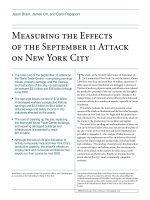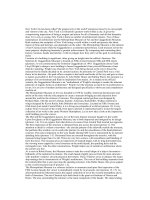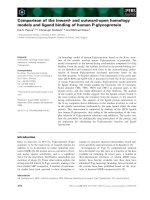comparison of the met and guggenheim museum new york
Bạn đang xem bản rút gọn của tài liệu. Xem và tải ngay bản đầy đủ của tài liệu tại đây (41.42 KB, 2 trang )
New York City has been called "the greatest city in the world" numerous times by its own people
and visitors to the city. New York is civilization's greatest world within a city. It gives the
overpowering impression of being a magnet and mirror for all of humanity and all that humanity
does. For a city so young, New York is home to number of architectural classics. Two of these
masterpieces of architecture are the Metropolitan Museum of Art and the Guggenheim Museum.
Both continue the metaphor of New York being a world within a world and possess the latent
fusion of form and function, one dependent on the other. The Metropolitan Museum is the epitome
of neo-Classical style while the Guggenheim is a modernist powerhouse. Each museum serves the
same purpose: displaying humanity's greatest achievements. By comparing and contrasting their
history, location, façade and interior, I will investigate how they arrive at this goal in contrasting
styles
Location of a building is significant, often giving an insight into the edifice's function. The
Solomon R. Guggenheim Museum is located on Fifth Avenue between 88th and 89th streets
(picture1). It was commissioned by Solomon Guggenheim in 1943. Guggenheim chose Frank
Lloyd Wright to design a new building to house Guggenheim's four-year-old Museum of non
objective painting. Wright was reluctant on New York being chosen as the city to house the
museum but he finally decided on its current location. Its proximity to Central Park was a vital
factor in his decision - the park offers a respite to the hustle and bustle of the city and gets as close
to nature as possible in the City (picture 2). Like Robie House and Falling Water, the museum is a
product of its environment and finds its inspiration from nature. As is stated on the official
website, the Guggenheim Museum is an "embodiment of Wright's attempts to render the inherent
plasticity of organic forms in architecture." People visit the museum as much for its architecture as
its art; it is an icon of modern architecture and designed specifically to showcase and complement
modern art.
The Metropolitan Museum of Art was founded in 1870 by wealthy American businessmen and
artists of the time with the sole purpose to create a museum bringing art and education from
around the world to the citizens of America. The original central pavilion was designed by
Richard Hunt, with the newer Lehman, Sackler, American, Rockefeller, Wallace and Kravis
wing's designed by Kevin Roche John Dinkeloo and Associates. Located on Fifth Avenue and
83rd street (just inside Central Park), it is a living encyclopedia of world art (picture 12). Every
culture from every part of the world, from past to present is represented and is in fact the largest
collection of art work in the entire Western Hemisphere. Let us now take a look at the impression
each building gives the viewer.
The Met and the Guggenheim possess two of the most famous museum façade's in the world.
Upon first glance at the Guggenheim Museum, one is both impressed and intrigued by its design
(pictures 1-4). It is an organic form that derives its source from Central Park located just opposite.
The best impression of the structure is obtained from just across the street (picture 1). The
attention to detail is evident everywhere - the circular pattern of the sidewalk outside the museum,
the porthole-like windows on its south side (picture 4), and the smoothness of the hand plastered
concrete. The main component on the west façade (facing Fifth Ave) is represented by an upward
spiraling helix (pictures 1-3). Horizontal lines are stressed throughout the exterior, with the
museum being longer than it is tall. There are very few corners, with smoothness and blending of
form the focus. The museum gives an impression of stacked shapes with its long horizontal base,
the viewing room capped by a steel structure on the north façade, the spiraling helix and the
rectangular core. Like his other constructions, Wright makes use of cantilever architecture where
the corners are free.
As is seen in Robie House, the Museum seems to take the overall shape of a ship or locomotive -
hallmarks of the industrial revolution. The south façade slightly juts out from the main structure
with 'porthole' windows cleverly placed at the bottom. These windows serve to enhance the steam
ship analogy that is characteristic of Wright's architecture. The core of the building emanates from
the central pillar that is seen just atop the spiraling structure. Like Robie House, this gives support
to the overall structure (top of pictures 1, 2).
The Metropolitan Museum is a colossus (relative to museums) and upon first inspection of the
Fifth Avenue facade, the viewer is immediately struck by its awesome size (pictures 12, 15). As
aforementioned the Museum houses the largest collection of art in the western hemisphere and is
built of limestone. The neo-Classical style hails back to the great civilizations of Greece and
Rome. The area surrounding the entrance is the main component of the façade. The steps leading
up to the entrance is reminiscent of the Parthenon and gives the building a sense of grandeur
(picture 15). This façade has three grand arches defined by pairs of Corinthian columns. There is a
cornice directly above the capitals . At the uppermost section of the entablature there is another
cornice that outlines the roof of the entire building (picture 16).
The main component of the façade is flanked by the west wing and east wing. The eastern section
is characterized by large dome shaped windows interrupted in between engaged Corinthian
columns (picture 13). Above the columns is another cornice that surrounds the length of the
building. There is a stepped in section that is perhaps designed to hold a sculpture. The south
façade is modernist and contrasts the classical style of the rest of the museum (picture 18). It is
composed of glass with a pyramidal dome in the central section. Each façade of the Met conveys a
sense of symmetry and order, in contrast to the Guggenheim Museum which is a fusion of
different forms.
The interior of both the Met and Guggenheim continue the theme of contrasting styles. The
Guggenheim Museum is a work of art itself and is as much a sculpture as it is architecture.
Reinforced concrete is used to create a soaring spiral that swells as it rises, culminating in an open
window rooftop. The viewer enters the museum through the central section of the façade and
arrives at the ground floor (picture 6). The entrance blends in with the surrounding sidewalk and is
difficult to perceive at first glance. Once inside, one sees the ramps of the building spiraling
upwards with the artwork displayed within each ramp (picture 5). Light streams down from the
glassed rooftop bathing the interior in sunlight giving the museum a warm ambience (picture
8,9,11). Wright designed the museum so that the art-goer could take the elevator on the left side of
the ground floor to the top ramp and gradually descend around an open court (picture 7). This
gives the viewer the option to skip levels and finally, at the end of the exhibition, find himself on
the ground floor, near the exit. By doing this, the viewer is made to experience the entire building,
from the top ramp, to the bottom and perceive the overall effect of the museum as a whole. One of
the consequences of this multi-ramp, open design is that the viewer can witness artwork on
multiple levels from one spot (picture 7). This is a unique attribute of the Guggenheim that is not
featured in other museums. However, a drawback to this is that walls of the interior are angled,
making it sometimes difficult to display conventionally shaped paintings. By using this style,
Wright conveys a very modernist sense to a building designed to display modern art. The Met
takes an almost completely opposite stance in performing its function.
The entrance to the Met is grand and inviting. Whereas the Guggenheim's entrance is almost
imperceptible with the sidewalk, the Met features nine ceremonial elevated staircases on which
stand Corinthian columns and grand arches (picture 15). As you enter the building through the
steps on the Fifth Avenue façade, you arrive at the Great Hall, one of the landmark rooms in New
York, comparable to Grand Central Station (pictures 19-23). The Great Hall is a huge, open room
with high domed ceilings, continuing the classical style (in particular, Romanesque) of the
exterior. Ionic columns flank the Great Hall on all four sides (picture 22). Above the columns
there is a cornice, above which is a balcony on the second floor. There are three directions in
which the viewer can access the displays, north, east, and west. If one continues straight (from the
entrance), there is a large grand staircase leading directly up to the second floor. Surrounding this
staircase is a set of parallel columns (picture 21). Just above the start of the staircase is a grand
statue of Perseus with the Head of Medusa. Unlike the Guggenheim museum, the Met offers a
more conventional method to view art. The art-goer walks through a number of interlocking rooms
with paintings on the sides and sculptures generally in the central area of the rooms. There is an
impression of class, symmetry and grandeur given by the Great Hall, viewing rooms and the
architecture of the Met.
The Guggenheim Museum and the Metropolitan Museum of New York are both masterpieces of
architecture that communicate their form and function in contrasting styles. The Met gives the
viewer a sense of grandeur and hails back to classical styles and forms while the Guggenheim
Museum intrigues and appeals to the aesthetic side of the viewer. Both Museum's are products of
their environment and accomplish the aesthetic effect that the art works inside them possess. If the
Met is considered graceful, the Guggenheim can be characterized as simply beautiful. Both are
priceless elements of the New York City architectural landscape.









